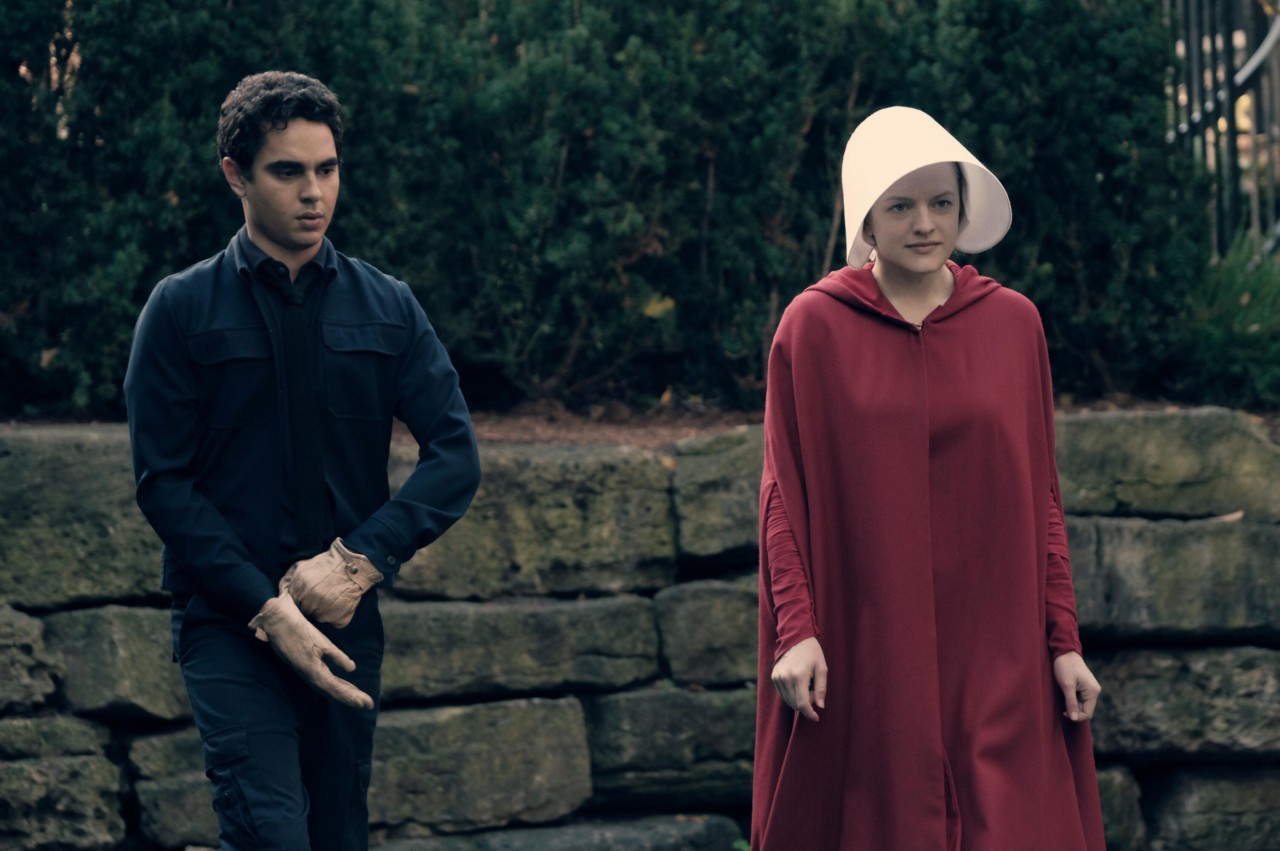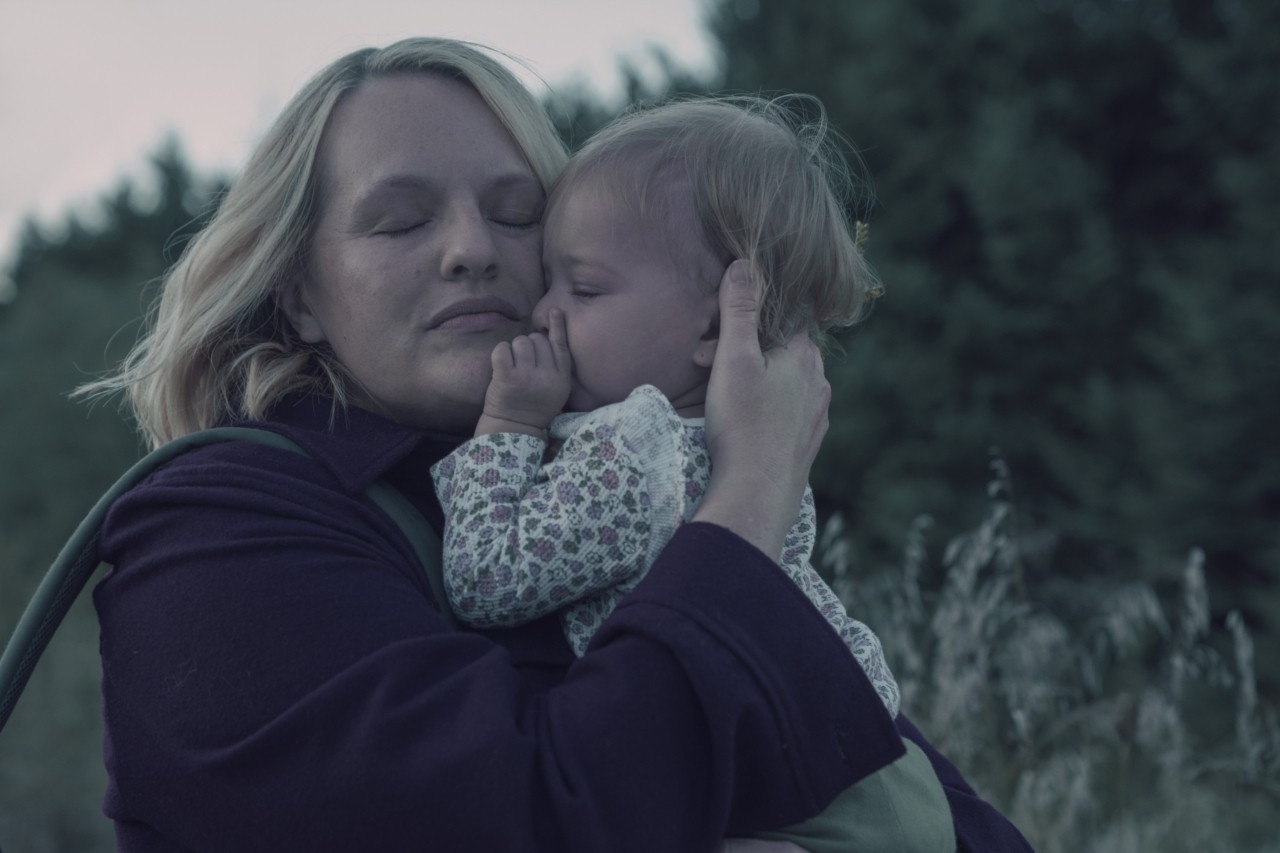

Photographs courtesy of Hulu
Words by Billie Walker
The sixth and final season of The Handmaid’s Tale, premiering on Hulu today, lands in a world eerily similar to the dystopia it portrays. But while the dark parts of human history the book and series were based on are well-documented, too little has been said of the story arcs inspired by resistance movements that quashed totalitarian theocracies of the past.
After five years of both covert and overt resistance to the patriarchal regime of Gilead, June (Elisabeth Moss)—a former handmaid still bearing the scars of sexual servitude—seeks refuge in Canada for fear of violent retaliation by the Christian theocracy. In the sixth season’s opening episode, June boards a train to Vancouver with a broken arm and festering infection from a violent attack and attempted murder by Gilead agents. Among many other refugees fleeing the rising tide of populism that threatens their safety, June is forced to evacuate Canada. The group finds itself in Alaska, where a temporary home has become a community of Gilead survivors.
The parallels to real-life mass deportations and detentions under the second Trump Administration—some carried out with scant legal basis—are hard to ignore. As are the parallels between certain real-life policies and the Gilead regime focus on limiting women’s freedoms and reproductive rights while punishing any critics.


The Handmaid’s Tale, a series adapted from the Margaret Atwood novel of the same name, depicts a world in which a fictional environmental disaster caused birth rates to plummet across the globe. Gilead, the tyrannical regime governing over most of the United States, uses the population crisis to justify authoritarian control over women’s bodies—capturing and enslaving fertile women, and placing them into forced surrogacy positions in the households of commanding officers. Infertile or rebellious citizens are condemned to the Colonies: a radioactive wasteland of toxic chemicals, where people are forced to work at cleaning the radioactive sites without protection. The Colonies serve as a grim reminder not only of the devastating consequences of ecological neglect, but also of a harsher truth: In a climate crisis, the living conditions of citizens will depend entirely on who holds power.
But while many right-wing politicians in the real world deny human-caused climate change entirely, Gilead attributes environmental degradation, cited as “an affront to God,” to America’s formerly liberal values. Like the commanders of Gilead, however, President Donald Trump—who recently pivoted from long-held denial to actively arguing that the climate crisis will benefit humanity—is quick to turn an emergency into an opportunity to self-promote and double down on his power.

The series is often touted as prophetic—especially now, with Trump just three months into a second term already marked by sweeping crackdowns on dissent and civil liberties. But to call it prophetic ignores the fascist movements and human rights abuses, both past and present, the book’s author and series’ writers intentionally draw from. Throughout the show’s six-season run, we have seen women sent to work in toxic dumping grounds (a reference to the Soviet Union’s uranium mines), suffer under relocation programs reminiscent of the Bantustan system in South Africa, live under driving bans akin to the one imposed on women in Saudi Arabia, and be subjected to female genital mutilation, a practice of global concern today. These are not fictional inventions—they echo real-world practices that have been imposed on women across history.
The key difference, however, is that in reality, such violence, enslavement, and systemic control have overwhelmingly targeted Indigenous, Black, and Arabic women in the Global South. In contrast, the show’s dystopian vision centers on these brutalities being inflicted on Western, predominantly white, women. Both the novel and the series have been critiqued for this framing—what is presented as a dystopian nightmare for white women has long been the generational trauma of many BIPOC women.
Even so, parts of The Handmaid’s Tale remain chillingly resonant today. In the show, pollution has caused a sharp decline in fertility rates; in reality, natal rates are dropping largely because of societal shifts: expanded opportunities for women, access to contraception, and the soaring cost of living. The governing regime in Gilead echoes certain platforms of the real-life, global far-right, from a disregard for female autonomy and disdain for reproductive justice to a commitment to a staunchly anti- LGBTQ+ and immigration agenda.
“In a climate crisis, the living conditions of citizens will depend entirely on who holds power.”
Gilead manipulates perception in a way that closely resembles the well-documented campaign of misinformation the real world is now accustomed to; often showcasing Gilead’s low pollution and rising fertility rates to foreign politicians as proof of the new regime’s success. Commander Waterford (Joseph Fiennes) and his wife Serena (Yvonne Strahovski) beam with patriotic pride in Season 3 Episode 11 when they compare what Gilead was once like, filled with factories and polluted air, with today. In their eyes, Gilead has “returned the world to its natural state.”
Serena, increasingly positioned as the regime’s public-facing ambassador, softens the Gilead government’s image by publicly embodying the ideal “trad wife,” a figure who champions traditional gender roles and espouses the values of domestic living. (Today, the tradwife lifestyle has exploded on social media, quickly gaining traction among Gen Z women.) “Gilead is the only country on the planet that has had an increase of live births,” she claims in Season 5 Episode 4, omitting the brutal truth: These numbers are the result of state-sanctioned rape and systemic violence. For every child born in The Handmaid’s Tale, countless lives are lost to Gilead’s merciless legal code where death is the penalty for homosexuality, treason, adultery, rape of another’s handmaid, and endangering a child. Whatever gains Gilead boasts in fertility is surely undercut by its staggering fatality rate.
The show’s power comes not from its ability to predict the future, but from its nuanced depiction of fascism’s past. And The Handmaid’s Tale makes clear that recognizing those historical patterns is essential to resisting their return.
Resistance takes many forms inside Gilead and beyond. From the show’s beginning, we see early resistance to the incurring fascist uprising. June and Moira (Samira Wiley) regularly attended marches protesting the new regime and its attack on women’s rights. But once the authority of Gilead takes control of the United States, tactics of rebellion change drastically.
Some of the handmaids resist their new life through violent acts. One handmaid commits an act of terrorism, charging into Gilead’s new Red Center wearing an explosive device (Season 2 Episode 6). Other acts of resistance are more subtle but equally profound, such as the women’s collective refusal to stone their fellow handmaid Janine (Season 1 Episode 10) in a moment of pacifist protest. Many of the handmaids’ strategies are inspired by the women’s suffrage movement, which used varying tactics from non-violent to militant in order to advocate for voting rights and other civil liberties for women.
In the show, many moments of solidarity and spreading of intel take place in the supermarket, the only place where the handmaids frequently gather. It is here that June first tells other handmaids her real name, not the state-sanctioned one given to handmaids to show they are a commander’s property. June’s act of defiance takes place against a backdrop of paranoia, which is encouraged by Gilead to keep citizens in line. But by naming one another, the handmaids form a quiet allegiance and dispel the suspicion they previously held over their shopping companions.


This subtle solidarity complements a more organized form of resistance through the Marthas—women forced into domestic slavery and named after Martha, a devoted biblical friend and servant of Jesus. Inspired by the historical Underground Railroad, which facilitated the escape of enslaved African and African American people from the 18th century onward, the Marthas secretly smuggle contraband, coordinate escapes, and are ultimately enlisted by June to help smuggle children out of Gilead (Season 3, Episode 10). Their work mirrors the efforts of Luke and Moira outside Gilead, who begin circulating letters from handmaids documenting their systematic abuse, smuggled into Canada by Nick on June’s behalf (Season 3, Episode 10). While these letters raise awareness internationally, it quickly becomes clear that resistance demands more than just a free press. From Season 2 on, the narrative spends considerable time with refugees in Canada, including Luke, Moira, and eventually June herself, who confront repeated obstacles from an American embassy prioritizing diplomacy over justice.
But all hope is not lost in Gilead. From the start, June hears whispers of “Mayday,” a secret resistance movement that handmaids speak of in hushed towns—a possible lifeline that could just as well be a comforting rumor that handmaids spread between themselves in pursuit of hope. Before long and with no intel of a Mayday uprising, June decides to become the resistance herself by embedding in the Martha’s network, helping another escape, and hiding an injured woman in her commander’s basement (Season 3, Episode 2).
It’s only after June escapes to Canada in the fifth season that she meets members of the Mayday militia. Until then, she had assumed the movement was a fantasy—something the handmaids invented to survive their nightmare. In the sixth and final season, The Handmaid’s Tale aligns more closely with Margaret Atwood’s feminist literature than ever before, much of which urges women to stop waiting for rescue and become their own heroes. It’s a message that has resonated far beyond the screen: In the U.K., U.S., and Argentina, protesters have donned handmaid’s uniforms while fighting for reproductive rights. In an era marked by the resurgence of far-right extremism, rising political instability, and escalating threats to women’s reproductive freedoms—from restrictive abortion laws in the U.S. to crackdowns on women’s rights globally—this call to action has never been more urgent.
If The Handmaid’s Tale leaves us with one call to action, it’s to be the dissenting voice you’ve been waiting for.

Final Season of ‘The Handmaid’s Tale’ Arrives in a World Too Close to Gilead





